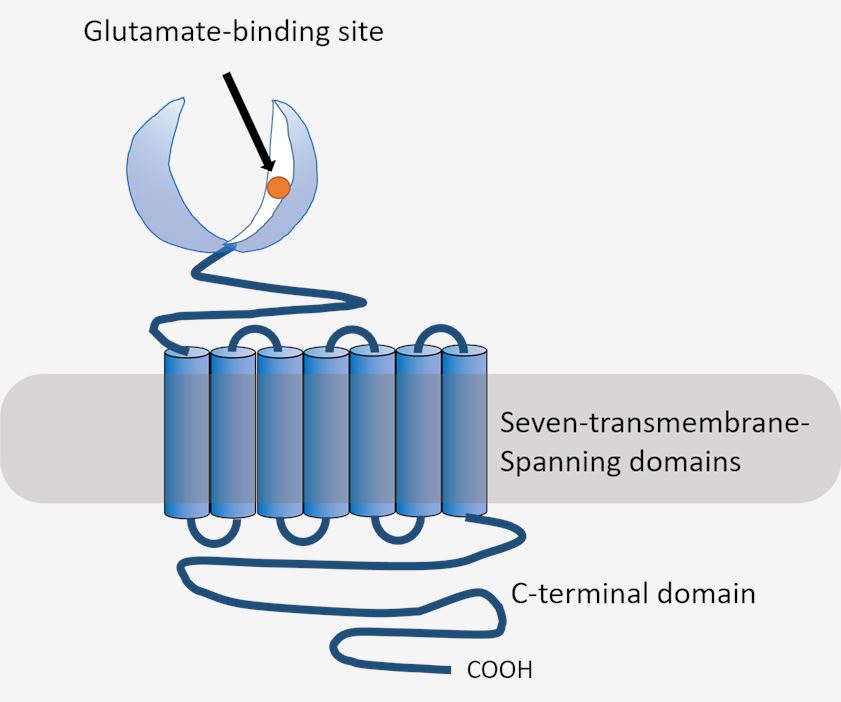Introduction of GRM5
mGluRs are family C G-protein-coupled receptors that are featured structurally by the presence of a large extracellular domain. Based on sequence homology, G-protein coupling, and ligand selectivity, mGluRs are subclassified into three groups: group I, group II, and group III. mGluR5, also known as GRM5, together with mGluR1, are group I mGluRs that are associated with Gq proteins and are coupled to phospholipase C. mGluR5 exists as two main splice variants: mGluR5a and mGluR5b. This receptor is localized postsynaptically and is highly expressed in the central nervous system, including the hippocampus, corpus striatum, cerebral cortex, and in basal ganglia.
| Basic Information of GRM5 | |
| Protein Name | Metabotropic glutamate receptor 5 |
| Gene Name | GRM5 |
| Organism | Homo sapiens (Human) |
| UniProt ID | P41594 |
| Transmembrane Times | 7 |
| Length (aa) | 1212 |
| Sequence |
MVLLLILSVLLLKEDVRGSAQSSERRVVAHMPGDIIIGALFSVHHQPTVDKVHERKCGAV REQYGIQRVEAMLHTLERINSDPTLLPNITLGCEIRDSCWHSAVALEQSIEFIRDSLISS EEEEGLVRCVDGSSSSFRSKKPIVGVIGPGSSSVAIQVQNLLQLFNIPQIAYSATSMDLS DKTLFKYFMRVVPSDAQQARAMVDIVKRYNWTYVSAVHTEGNYGESGMEAFKDMSAKEGI CIAHSYKIYSNAGEQSFDKLLKKLTSHLPKARVVACFCEGMTVRGLLMAMRRLGLAGEFL LLGSDGWADRYDVTDGYQREAVGGITIKLQSPDVKWFDDYYLKLRPETNHRNPWFQEFWQ HRFQCRLEGFPQENSKYNKTCNSSLTLKTHHVQDSKMGFVINAIYSMAYGLHNMQMSLCP GYAGLCDAMKPIDGRKLLESLMKTNFTGVSGDTILFDENGDSPGRYEIMNFKEMGKDYFD YINVGSWDNGELKMDDDEVWSKKSNIIRSVCSEPCEKGQIKVIRKGEVSCCWTCTPCKEN EYVFDEYTCKACQLGSWPTDDLTGCDLIPVQYLRWGDPEPIAAVVFACLGLLATLFVTVV FIIYRDTPVVKSSSRELCYIILAGICLGYLCTFCLIAKPKQIYCYLQRIGIGLSPAMSYS ALVTKTNRIARILAGSKKKICTKKPRFMSACAQLVIAFILICIQLGIIVALFIMEPPDIM HDYPSIREVYLICNTTNLGVVTPLGYNGLLILSCTFYAFKTRNVPANFNEAKYIAFTMYT TCIIWLAFVPIYFGSNYKIITMCFSVSLSATVALGCMFVPKVYIILAKPERNVRSAFTTS TVVRMHVGDGKSSSAASRSSSLVNLWKRRGSSGETLRYKDRRLAQHKSEIECFTPKGSMG NGGRATMSSSNGKSVTWAQNEKSSRGQHLWQRLSIHINKKENPNQTAVIKPFPKSTESRG LGAGAGAGGSAGGVGATGGAGCAGAGPGGPESPDAGPKALYDVAEAEEHFPAPARPRSPS PISTLSHRAGSASRTDDDVPSLHSEPVARSSSSQGSLMEQISSVVTRFTANISELNSMML STAAPSPGVGAPLCSSYLIPKEIQLPTTMTTFAEIQPLPAIEVTGGAQPAAGAQAAGDAA RESPAAGPEAAAAKPDLEELVALTPPSPFRDSVDSGSTTPNSPVSESALCIPSSPKYDTL IIRDYTQSSSSL |
Functions of GRM5 Membrane Protein
GRM5 knockout mice have been intensively studied for an understanding of its functions in different neurological disorders, such as Alzheimer’s disease, fragile X syndrome, schizophrenia, drug abuse and addiction, and obesity. In models of drug abuse and addiction, GRM5-deficient mice do not self-administer cocaine and show no increased locomotor activity following cocaine treatment. Besides, these animals showed reduced rapid eye movement sleep during the light phase, enhanced motor behavior and body temperature during the dark phase, and reduced slow wave activity and sleep drive after sleep deprivation, suggesting an important role in maintaining sleep homeostasis. In addition, GRM5 is implicated in the treatment of fragile X syndrome and modulates food intake and energy balance, which are concluded from studies in mice lacking GRM5. As a result, selective antagonists and negative allosteric modulators of GRM5 are a particular area of interest for pharmaceutical research.

Applications of GRM5 Membrane Protein
This article explored the relationship of mGluR5 with glucocorticoid receptor (GR) or cannabinoid receptor (CB1) and the molecular mechanism of susceptibility and resilience to acute stress (AS) and chronic mild stress (CMS). The results suggested that GR and CB1 in the hippocampus might regulate mGluR5 protein and mRNA levels, which might be related to individual responses of susceptibility and resilience under AS and CMS.
By using the mGluR5 antagonist MPEP, this article tested the effect of acute pharmacological inhibition of mGluR5 activity on the extinction of fear memory and spatial memory. The data suggested a necessary role of mGluR5 in regulating certain aspects of behavioral flexibility.
This article evaluated the effects of MPEP, a selective antagonist of the mGluR5 on the acquisition, expression, and reinstatement of ethanol conditioned place preference. The results indicated that mGluR5 might be involved in the expression and reinstatement of conditioned rewarding effects of ethanol, but not the acquisition of ethanol.
This article demonstrated that novel neuroprotective agent with improved potency might be developed by mimicking the chemical structure of DFB, using a combination of computer-aided drug design (CADD), synthetic chemistry and biological evaluations.
This article investigated whether inhibition of glutamatergic transmission by the mGluR5 antagonist MTEP could have antidepressant potential in models induced by injection of L-AAA. The results showed that this method produced a useful model of depression and MTEP exhibited antidepressant potential.
GRM5 Preparation Options
Creative Biolabs has years of experience providing outsourcing services with a skilled team of scientists who will work with you in preparing your membrane protein of interest. We utilize different strategies and reconstitution systems to prepare your targets in solubilized, stable, active formats. For more information, please see Magic™ Membrane Protein Production Service. Aided by our versatile Magic™ anti-membrane protein antibody discovery platform, we also provide customized anti-GRM5 antibody development services.
Our advanced membrane protein production platform and technologies help maximize the yield and purity of the targets while preserving their native structure and activity. If you are interested in our services, contact us to learn about more information.
All listed services and products are For Research Use Only. Do Not use in any diagnostic or therapeutic applications.